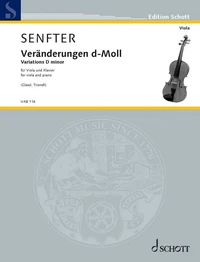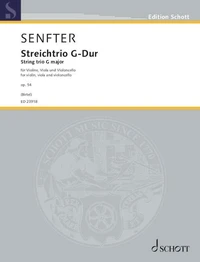Edition Schott
String Quartet F sharp minor. edited by Wolfgang Birtel. op. 28. 2 violins, viola and cello. Partition et parties.
Par : Formats :
- Paiement en ligne :
- Livraison à domicile ou en point Mondial Relay estimée à partir du 4 décembreCet article sera commandé chez un fournisseur et vous sera envoyé 10 jours après la date de votre commande.
- Retrait Click and Collect en magasin gratuit
- Livraison à domicile ou en point Mondial Relay estimée à partir du 4 décembre
- Réservation en ligne avec paiement en magasin :
- Indisponible pour réserver et payer en magasin
- Nombre de pages112
- Poids0.376 kg
- Dimensions23,1 cm × 30,3 cm × 0,0 cm
- ISBNM-001-17647-1
- EAN9790001176477
- Date de parution01/01/2000
- CollectionMUSIQUE D'ENSEM
- ÉditeurSchott
- EditeurWolfgang Birtel
Résumé
The composer Johanna Senfter (1879 1961) from Oppenheim concerned herself with chamber music for strings all her life, even studied violin in Frankfurt herself. Max Reger then gave her lessons in Leipzig, first privately, then in his composition class at the conservatoire and valued her 'extraordinary compositional talent'. The strict teacher more and more became a committed promoter of the works by Johanna Senfter.
For a period of 50 years, the composer concerned herself with the string quartet genre, from Quartet No. 1 in D minor Op. 4, composed shortly after the turn of the century, to the sixth and last Quartet in C minor Op. 115 which was performed for the first time in 1960, one year before her death. The Quartet in F sharp minor Op. 28 is her second quartet which was premiered in Darmstadt on 5 November 1922.
In this work, as in later works, Senfter combined traditional form models - here Baroque movements like gavotte, saraband, gigue - with expressive, late Romantic musical language. The work, consisting of six short movements, may without doubt be regarded as a valuable addition to the quartet repertoire. Instrumentation : 2 violins, viola and cello op. 28
For a period of 50 years, the composer concerned herself with the string quartet genre, from Quartet No. 1 in D minor Op. 4, composed shortly after the turn of the century, to the sixth and last Quartet in C minor Op. 115 which was performed for the first time in 1960, one year before her death. The Quartet in F sharp minor Op. 28 is her second quartet which was premiered in Darmstadt on 5 November 1922.
In this work, as in later works, Senfter combined traditional form models - here Baroque movements like gavotte, saraband, gigue - with expressive, late Romantic musical language. The work, consisting of six short movements, may without doubt be regarded as a valuable addition to the quartet repertoire. Instrumentation : 2 violins, viola and cello op. 28
The composer Johanna Senfter (1879 1961) from Oppenheim concerned herself with chamber music for strings all her life, even studied violin in Frankfurt herself. Max Reger then gave her lessons in Leipzig, first privately, then in his composition class at the conservatoire and valued her 'extraordinary compositional talent'. The strict teacher more and more became a committed promoter of the works by Johanna Senfter.
For a period of 50 years, the composer concerned herself with the string quartet genre, from Quartet No. 1 in D minor Op. 4, composed shortly after the turn of the century, to the sixth and last Quartet in C minor Op. 115 which was performed for the first time in 1960, one year before her death. The Quartet in F sharp minor Op. 28 is her second quartet which was premiered in Darmstadt on 5 November 1922.
In this work, as in later works, Senfter combined traditional form models - here Baroque movements like gavotte, saraband, gigue - with expressive, late Romantic musical language. The work, consisting of six short movements, may without doubt be regarded as a valuable addition to the quartet repertoire. Instrumentation : 2 violins, viola and cello op. 28
For a period of 50 years, the composer concerned herself with the string quartet genre, from Quartet No. 1 in D minor Op. 4, composed shortly after the turn of the century, to the sixth and last Quartet in C minor Op. 115 which was performed for the first time in 1960, one year before her death. The Quartet in F sharp minor Op. 28 is her second quartet which was premiered in Darmstadt on 5 November 1922.
In this work, as in later works, Senfter combined traditional form models - here Baroque movements like gavotte, saraband, gigue - with expressive, late Romantic musical language. The work, consisting of six short movements, may without doubt be regarded as a valuable addition to the quartet repertoire. Instrumentation : 2 violins, viola and cello op. 28











